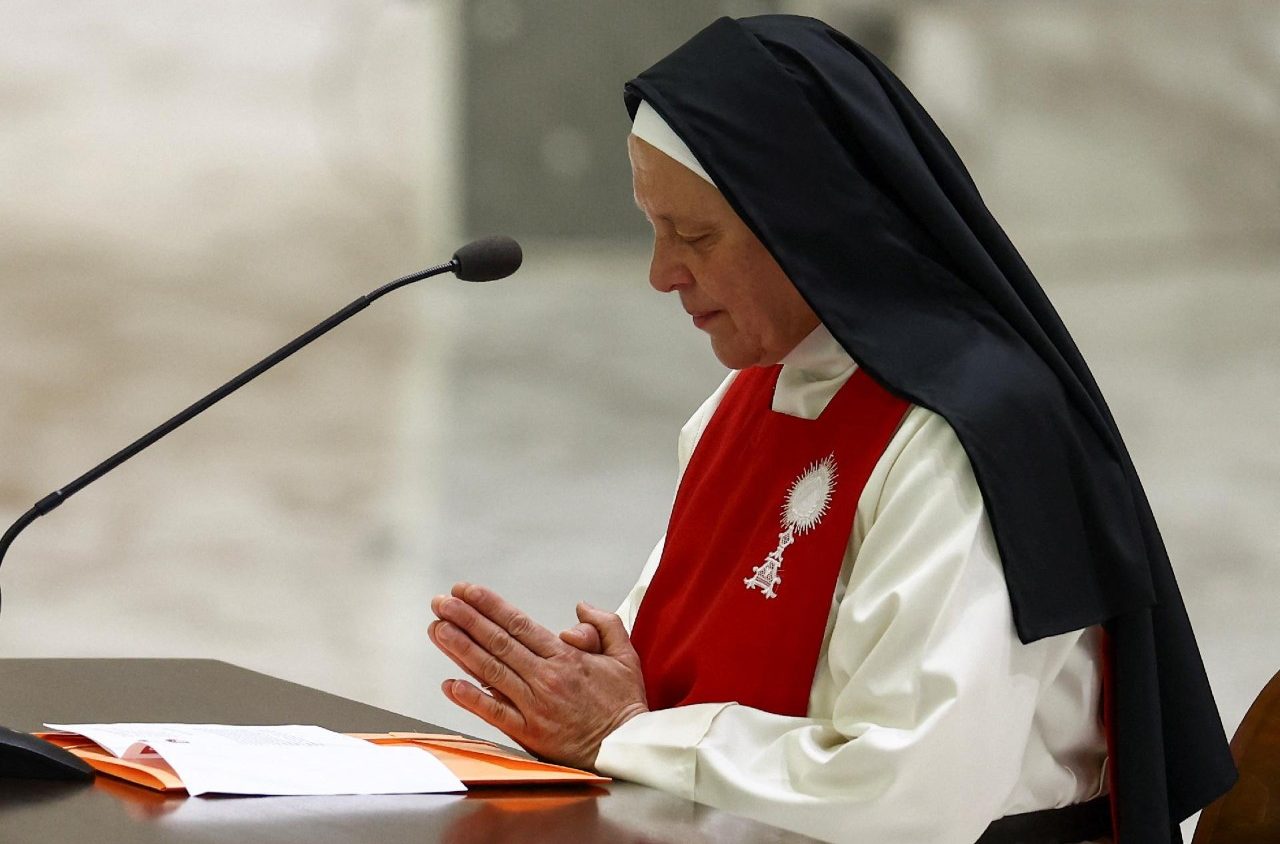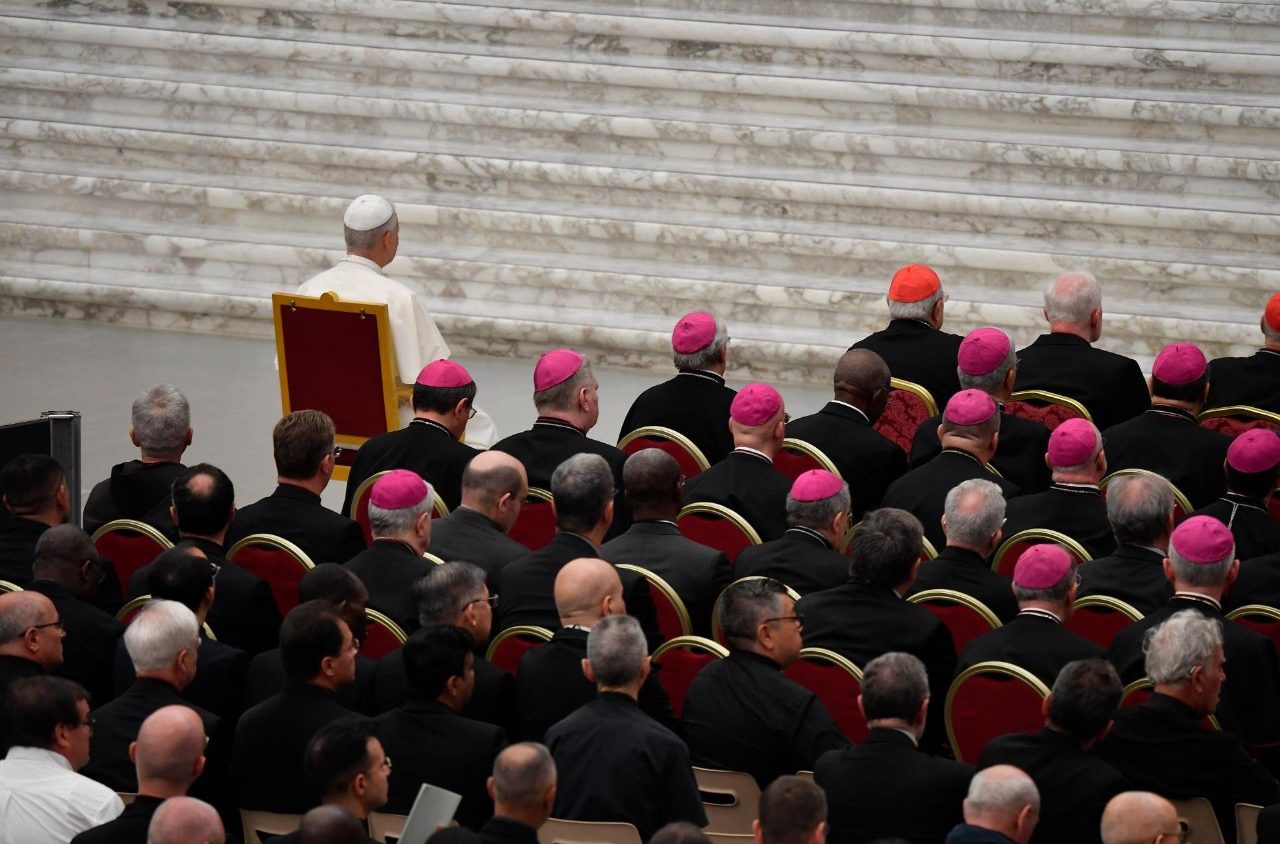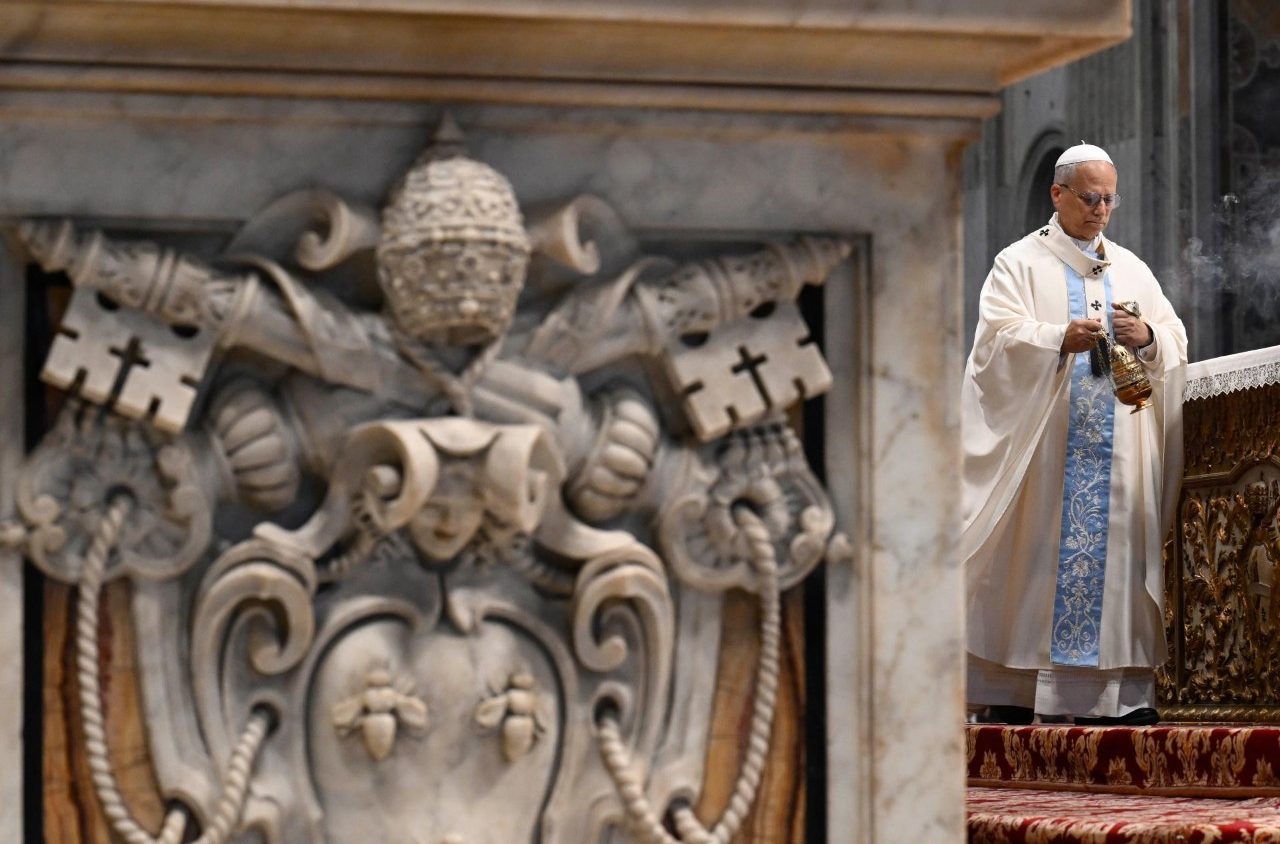🇮🇹 Versione italiana
Vatican City – On 9 June 2025, the Holy See’s Jubilee was celebrated in the Vatican. This symbolic event involves not only the Roman Pontiff but also the entire institution that assists him in governing the universal Church. Indeed, the Code of Canon Law specifies that — unless the context indicates otherwise — the term Apostolic See or Holy See refers not only to the Pope but also to the Secretariat of State, the Council for the Public Affairs of the Church, and the other bodies of the Roman Curia.

Hope is Living for Eternity
At 10:00 a.m., Sister Maria Gloria Riva, a Perpetual Adorer of the Blessed Sacrament, offered the Pontiff and the Holy See a profound and compelling meditation. Seamlessly combining biblical wisdom, spiritual depth, and cultivated culture, Riva delivered authentic catechesis on hope, the central theme of the 2025 Jubilee—a virtue often forgotten yet more necessary than ever.
Drawing from the Hebrew term tikva, evoking the image of a rope stretched between past and future, she presented hope as a vital tension that avoids both nostalgic retreat and futuristic illusion. With reference to de Chirico’s The Prodigal Son, she demonstrated how art can be a modern parable of a lost humanity and an invitation to return to the Father. Her reflection touched upon contemporary perils: loss of roots, media dominance, and the danger of living without direction.
“Today we risk living in nostalgia for a past that no longer is—leading into a traditionalism detached from the present—or rushing towards a future that doesn’t yet exist, falling into an illusory futurism incapable of offering real solutions to today’s challenges. The past, in truth, with its pains and its glories, can represent a great springboard to live the present in the right tension,” she said.
Echoing St Augustine, she emphasised that one cannot run well without knowing the goal. She suggested that eternal life and Christ’s Resurrection are the only sure horizons that do not disappoint. Hope, she said, recalling Augustinian and Péguy-like nuance, is that “little girl” who accompanies faith and charity, helping us to read history with wonder and humility—qualities alone capable of recognising good even in suffering.
Central to this journey is the Eucharist, binding past, present, and future—a place where faith, charity, and hope become flesh. She recalled how the founder of her Order, Blessed Maria Magdalena of the Incarnation, received from Jesus himself the call to establish in Rome, beside the Pope, a monastery that would serve as a lighthouse of adoration and intercession for the whole Church—especially in times of crisis.
Finally, Sister Riva evoked Salvador Dalí’s Madonna of Port Lligat as a powerful image of the Virgin Mary who, even amid ruins, preserves the possibility of rebirth and salvation. At the centre of Mary’s womb—and the centre of history—is the Child Jesus; within the Child, the Eucharistic Bread, a sublime sign of the divine wisdom sustaining the universe. In this mystery, Sister Maria Gloria outlined the sure path of Christian hope: to be rooted in the Eucharist, guided by Mary, and to trust that the beauty of the Cross—welcomed and offered—can still save the world.

To Serve the Holy See? Strive to be Saints
Upon concluding the meditation, Pope Leo XIV took the Jubilee Cross and, in prayerful silence, began the procession towards the Holy Door. Behind him walked cardinals, bishops, priests, and lay people. Yet the latter seemed to experience the moment more as a stroll through Villa Borghese than an act of solemnity and penance.
What we witnessed today is perhaps the clearest and most disheartening consequence of years of amoral familism pervading the Leonine walls: a cringe-worthy, at times grotesque, snapshot of the current state of the Roman Curia. Faces paraded in the Paul VI Hall that have no real connection to the Holy See, except through networks of favour and complicity. “Friends of friends” recruited for convenience, not merit—figures who contribute nothing substantial and are often the very sources of toxic gossip and discord. Yet they manage to infiltrate reserved moments simply to boast of their presence at exclusive events.
Among them, laypeople like Paolo Ruffini appeared utterly distracted—glancing around bewildered, laughing and chatting, sunglasses lowered, with vacant expressions: a vibe more of a picnic outing than a Jubilee. What example do these closest collaborators of the Pope set for a watching world? Prayer seems to be unknown to them, and recollection mere wasted time. On the stage of the Paul VI Hall, after the nun’s meditation, a speaker took to the podium, unable to articulate full sentences and stumbling repeatedly over his words.
Their ears must have burned when the Pope, in his homily, declared: “Thus the Apostolic See guards the sanctity of its roots even as it is guarded by them. But it is no less true that it also lives in the holiness of each of its members. Therefore, the best way to serve the Holy See is to strive to be holy, each according to their state of life and the responsibility entrusted to them.”
In the Basilica, as the procession continued with the chanting of litanies, some sang off-key without any hint of shame, microphones in hand. Much is spoken of the struggles of local Churches, but here the situation is far graver. Today the Holy See stands as the distorted mirror of twelve years of paralysis, cronyism, and structural decay. Not a Jubilee—perhaps it’s time to start signing some resignation letters.

The Church’s Fruitfulness Depends on Christ’s Cross
At 11:30 a.m., in St Peter’s Basilica, the Eucharistic celebration, presided over by Pope Leo XIV, took place. The liturgy today poignantly commemorated Mary, Mother of the Church—a Marian title of extraordinary theological and ecclesiological significance, rooted in the Second Vatican Council and given full expression by Saint Paul VI. In fact, it was Pope Montini who publicly announced this recognition during the general audience on 18 November 1964 and solemnly proclaimed it on 21 November that same year, at the close of the Council’s third session. He defined Mary as “Mother of the Church, that is, of the entire People of God, both the faithful and the Pastors”, urging that she be invoked and honoured by this sweetest of titles.
In the Concluding Address of the Council on 7 December 1965, Paul VI again called upon her with heartfelt words: “We implore the help of the Blessed Virgin Mary, Mother of Christ, whom we also call Mother of the Church.” Montini further desired that this title have liturgical expression: in 1973, the votive Mass De Sancta Maria Ecclesiae Mater was approved, and two years later incorporated into the new edition of the Roman Missal; in his encyclical Christi Matri(15 September 1966), he invited the faithful to entrust themselves to her intercession for the gift of peace.
Into this ecclesial and spiritual current flowed the intense homily of Pope Leo XIV, who began by stressing the grace of celebrating the Holy See’s Jubilee on the very feast of the Mother of the Church. He described it as a “happy coincidence”, read through the light of the Holy Spirit who, on yesterday’s Solemnity of Pentecost, was poured out upon the Church, renewing her countenance.
The Pontiff interpreted the day’s readings—two biblical icons from the Acts of the Apostles (1:12–14) and the Gospel of John (19:25–34)—as illuminating the mystery of the Church, and within it, the role of the Holy See.
With theological subtlety, Leo XIV centred his meditation on the mystery of Mary’s spiritual motherhood, born of Christ’s supreme act of love on the Cross. It is precisely there, in the heart of Good Friday, that the “unthinkable leap”occurs: Mary ceases to be simply the Mother of the Incarnate Word and becomes the new Eve—the Mother of all those living in grace, united by Christ to his redemptive Passion and the birth of the new People of God.
“All the fruitfulness of the Church and of the Holy See,” declared the Pope, “depends on the Cross of Christ. Otherwise, it is mere appearance—or worse.”
Quoting theologian Hans Urs von Balthasar, he affirmed that the tree of the Church grows from the tiny seed of the Cross, and only insofar as it bears cross-shaped fruit does it reveal its authenticity.
From a deeply spiritual and concrete perspective, Leo XIV stressed that this ecclesial fruitfulness is reflected in the holiness of its members—a holiness lived, incarnate, often hidden, and quotidian. He cited the example of a priest who, despite bearing a heavy cross because of his ministry, goes to his office each day and strives to perform his duties with love and faith; or of a father and mother who, in the face of familial struggles and everyday hardships, persevere with responsibility and love.
“For instance, a priest who personally carries a heavy cross on account of his ministry, yet each day goes to the office and seeks to do his work with love and faith—this priest participates in and contributes to the fruitfulness of the Church.”
Thus, the Holy See is holy—not only because it is founded on Peter’s rock, but because each member, in living their service, cooperates in its spiritual fruitfulness.
In the second part of the homily, the Pope reflected on the icon of Mary in the Upper Room—an image of the nascent Church gathered in prayer, awaiting the Spirit. Mary, he said, is the “living memory of Jesus”, whose presence harmonises the disciples’ diversity, making communal prayer truly con‑corde. The presence of Peter—named first among the Apostles yet upheld by Mary’s motherhood—also carries significance. In this balance between the Petrine ministry and Marian charism, one comes to understand the mystery of the Holy See, whose holiness and fruitfulness are sustained by the Marian key—a gift of the Crucified and Risen One.
The homily concluded with a heartfelt call to personal and communal holiness, lived in the everyday. As the Pope said, enlightened by the Word, we can renew the Collect’s prayer: that the Church, upheld by Christ’s love, may become ever more fruitful in the Spirit, rejoice in the holiness of its children, and gather the entire human family into her womb.
f.P.S.
Silere non possum